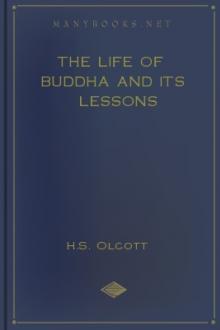Man, Past and Present, Agustus Henry Keane, A. Hingston Quiggin, Alfred Court Haddon [series like harry potter txt] 📗

Book online «Man, Past and Present, Agustus Henry Keane, A. Hingston Quiggin, Alfred Court Haddon [series like harry potter txt] 📗». Author Agustus Henry Keane, A. Hingston Quiggin, Alfred Court Haddon
Admirable alike for its manifold aptitudes and surprising vitality, the language of Aeschylus, Thucydides, and the other great Athenians outlived all the vicissitudes of the Byzantine empire, during which it was for a time banished from Southern Greece, and even still survives, although in a somewhat degraded form, in the Romaic or Neo-Hellenic tongue of modern Hellas. Romaic, a name which recalls a time when the Byzantines were known as "Romans" throughout the East, differs far less from the classical standard than do any of the Romance tongues from Latin. Since the restoration of Greek independence great efforts have been made to revive the old language in all its purity, and some modern writers now compose in a style differing little from that of the classic period.
Yet the Hellenic race itself has almost perished on the mainland. Traces of the old Greek type have been detected by Lenormant and others, especially amongst the women of Patras and Missolonghi. But within living memory Attica was still an Albanian land, and Fallmerayer has conclusively shown that the Peloponnesus and adjacent districts had become thoroughly Slavonised during the 6th and 7th centuries[1293]. "For many centuries," writes the careful Roesler, "the Greek peninsula served as a colonial domain for the Slavs, receiving the overflow of their population from the Sarmatian lowlands[1294]." Their presence is betrayed in numerous geographical terms, such as Varsova in Arcadia, Glogova, Tsilikhova, etc. Nevertheless, since the revival of the Hellenic sentiment there has been a steady flow of Greek immigration from the Archipelago and Anatolia; and the Albanian, Slav, Italian, Turkish, Rumanian, and Norman elements have in modern Greece already become almost completely Hellenised, at least in speech. Of the old dialects Doric alone appears to have survived in the Tsaconic of the Laconian hills. The Greek language has, however, disappeared from Southern Italy, Sicily, Syria, and the greater part of Egypt and Asia Minor, where it was long dominant.
To understand the appearance of SLAVS in the Peloponnesus we must go back to the Eurasian steppe, the probable cradle of these multitudinous populations. Here they have often been confused with the ancient Sarmatae, who already before the dawn of history were in possession of the South Russian plains between the Scythians towards the east and the proto-Germanic tribes before their migration to the Baltic lands. But even at that time, before the close of the Neolithic Age, there must have been interminglings, if not with the western Teutons, almost certainly with the eastern Scythians, which helps to explain the generally vague character of the references made by classical writers both to the Sarmatians and the Scythians, who sometimes seem to be indistinguishable from savage Mongol hordes, and at others are represented as semi-cultured peoples, such as the Aryans of the Bronze period might have been round about the district of Olbia and the other early Miletian settlements on the northern shores of the Euxine.
Owing to these early crossings Andre Lefevre goes so far as to say that "there is no Slav race[1295]," but only nations of divers more or less pure types, more or less crossed, speaking dialects of the same language, who later received the name of Slavs, borne by a prehistoric tribe of Sarmatians, and meaning "renowned," "illustrious[1296]." Both their language and mythologies, continues Lefevre, point to the vast region near Irania as the primeval home of the Slav, as of the Celtic and Germanic populations. The Sauromatae or Sarmatae of Herodotus[1297], who had given their name to the mass of Slav or Slavonised peoples, still dwelt north of the Caucasus and south of the Budini between the Caspian, the Don and Sea of Azov; "after crossing the Tanais (Don) we are no longer in Scythia; we begin to enter the lands of the Sauromatae, who, starting from the angle of the Palus Moeotis (Sea of Azov), occupy a space of 15 days' march, where are neither trees, fruit-trees, nor savages. Above the tract fallen to them the Budini occupy another district, which is overgrown with all kinds of trees[1298]." Then Herodotus seems to identify these Sarmatians with the Scythians, whence all the subsequent doubts and confusion. Both spoke the same language, of which seven distinct dialects are mentioned, yet a number of personal names preserved by the Greeks have a certain Iranic look, so that these Scythian tongues seem to have been really Aryan, forming a transition between the Asiatic and the European branches of the family.
The probable explanation is that the Scythians[1299] were a horde which came down from Upper Asia, conquered an Iranian-speaking people, and in time adopted the speech of its subjects. E. H. Minns[1300] suggests that the settled Scythians represent the remains of the Iranian population, and the nomads the conquering peoples. These were displaced later by the Sarmatians, and Scythia becomes merely a geographical term. Skulls dug up in Scythic graves throw no light on racial affinities, some being long, and some short, but in customs there is a close analogy with the Mongols, though, as Minns points out, "the natural conditions of steppe-ranging dictated the greater part of them."
Both Slav and Germanic tribes had probably in remote times penetrated up the Danube and the Volga, while some of the former under the name of Wends (Venedi[1301]), appear to have reached the Carpathians and the Baltic shores down the Vistula. The movement was continued far into medieval times, when great overlappings took place, and when numerous Slav tribes, some still known as Wends, others as Sorbs, Croats, or Chekhs, ranged over Central Europe to Pomerania and beyond the Upper Elbe to Suabia. Most of these have long been Teutonised, but a few of the Polabs[1302] survive as Wends in Prussian and Saxon Lausatz, while the Chekhs and Slovaks still hold their ground in Bohemia and Moravia, as the Poles do in Posen and the Vistula valley, and the Rusniaks or Ruthenes with the closely allied "Little Russians," in the Carpathians, Galicia, and Ukrania.
It was from the Carpathian[1303] lands that came those Yugo-Slavs("Southern Slavs") who, under the collective name of Sorbs (Serbs, Servians), moved southwards beyond the Danube, and overran a great part of the Balkan peninsula and nearly the whole of Greece in the 6th and 7th centuries. They were the Khorvats[1304] or Khrobats[1304] from the upland valleys of the Oder and Vistula, whom, after his Persian wars, Heraclius invited to settle in the wasted provinces south of the Danube, hoping, as Nadir Shah did later with the Kurds in Khorasan, to make them a northern bulwark of the empire against the incursions of the Avars and other Mongolo-Turki hordes. Thus was formed the first permanent settlement of the Yugo-Slavs in Croatia, Istria, Dalmatia, Bosnia, and the Nerenta valley in 680, under the five brothers Klukas, Lobol, Kosentses, Mukl, and Khrobat, with their sisters Tuga and Buga. These were followed by the kindred Srp (Sorb) tribes from the Elbe, who left their homes in Misnia and Lusatia, and received as their patrimony the whole region between Macedonia and Epirus, Dardania, Upper Moesia, the Dacia of Aurelian, and Illyria, i.e. Bosnia and Servia. The lower Danube was at the same time occupied by the Severenses, "Seven Nations," also Slavs, who reached to the foot of the Hemus beyond the present Varna. Nothing could stem this great Slav inundation, which soon overflowed into Macedonia (Rumelia), Thessaly, and Peloponnesus, so that for a time nearly the whole of the Balkan lands, from the Danube to the Mediterranean, became a Slav domain--parts of Illyria and Epirus (Albania) with the Greek districts about Constantinople alone excepted.
Hellas, as above seen, has recovered itself, and the Albanians[1305], direct descendants of the ancient Illyrians, still hold their ground and keep alive the last echoes of the old Illyrian language, which was almost certainly a proto-Aryan form of speech probably intermediate, as above-mentioned, between the Italic and Hellenic branches. They even retain the old tribal system, so that there are not only two main sections, the northern Ghegs and the southern Toshks, but each section is divided into a number of minor groups[1306], such as the Malliesors (Klementi, Pulati, Hoti, etc.) and Mirdites (Dibri, Fandi, Matia, etc.) in the north, and the Toxides (whence Toshk) and the Yapides (Lapides) in the south. The southerners are mainly Orthodox Greeks, and in other respects half-Hellenised Epirotes, the northerners partly Moslem and partly Roman Catholics of the Latin rite. From this section came chiefly those Albanians who, after the death (1467) of their valiant champion, George Castriota (Scanderbeg, "Alexander the Great"), fled from Turkish oppression and formed numerous settlements, especially in Calabria and Sicily, and still retain their national traditions.
In their original homes, located by some between the Bug and the Dnieper, the Slavs have not only recovered from the fierce Mongolo-Turki and Finn tornadoes, by which the eastern steppes were repeatedly swept for over 1500 years after the building of the Great Wall, but have in recent historic times displayed a prodigious power of expansion second only to that of the British peoples. The Russians (Great, Little, and White Russians), whose political empire now stretches continuously from the Baltic to the Pacific, have already absorbed nearly all the Mongol elements in East Europe, have founded compact settlements in Caucasia and West Siberia, and have thrown off numerous pioneer groups of colonists along all the highways of trade and migration, and down the great fluvial arteries between the Ob and the Amur estuary. They number collectively over 100 millions, with a domain of some nine million square miles. The majority belong to Deniker's Eastern race[1307] (a variety of the Alpine type), being blond, sub-brachycephalic and short, 1.64 m. (5 ft. 4-1/2 ins.). The Little Russians in the South on the Black Mould belt are more brachycephalic and have darker colouring and taller stature. The White Russians in the West between Poland and Lithuania are the fairest of all.
We need not be detained by the controversy carried on between Sergi and Zaborowski regarding a prehistoric spread of the Mediterranean race to Russia[1308]. The skulls from several of the old Kurgans, identified by Sergi with his Mediterranean type, have not been sufficiently determined as to date or cultural periods to decide the question, while their dolicho shape is common both to the Mediterraneans and to the proto-Aryans of the North European type[1309]. To this stock the proto-Slavs are affiliated by Zaborowski and many others[1310], although the present Slavs are all distinctly round-headed. Ripley asks, almost in despair, what is to be done with the present Slav element, and decides to apply "the term Homo Alpinus to this broad-headed group wherever it occurs, whether on mountains or plains, in the west or in the east[1311]."
We are beset by the same difficulties as we pass with the Ossets of the Caucasus into the Iranian and Indian domains of the proto-Aryan peoples. These Ossets, who are the only aborigines of Aryan speech in Caucasia, are by Zaborowski[1312] identified with the Alans, who are already mentioned in the 1st century A.D. and were Scythians of Iranian speech, blonds, mixed with Medes, and perhaps descendants of the Massagetae. We know from history that the Goths and Alans became closely united, and it may be from the Goths that the Osset descendants of the Alans (some still call themselves Alans) learned to brew beer. Elsewhere[1313] Zaborowski represents the Ossets as of European origin, till lately for the most part blonds, though now showing many Scythian traits. But they are not physically Iranians "despite the Iranian and Asiatic origin of their language," as shown by Max Kowalewsky[1314]. On the whole, therefore, the Ossets may be taken as originally blond Europeans, closely blended with Scythians, and later with the other modern Caucasus peoples, who are mostly brown brachys. But Ernest Chantre[1315] allies these groups to their brown and brachy Tatar neighbours, and denies that the Ossets are the last remnants of Germanic immigrants into Caucasia.
We have therefore in the Caucasus a very curious and puzzling phenomenon--several somewhat distinct groups of aborigines, mainly of de





Comments (0)